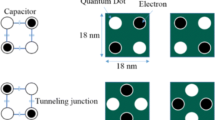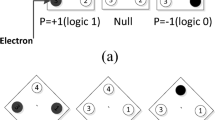Abstract
Quantum-dot cellular automata (QCA) is a highly attractive alternative to CMOS for the future digital circuit design. Current methods for designing circuits in QCA, especially decoders, mainly refer to traditional CMOS circuit design methods, which do not make full use of the characteristics of QCA technology. For our purpose, the three-input majority gate in QCA is analyzed and a combinational logic gate that fully embodies the majority characteristics is then proposed. A matrix representation method for decoders using the logic gates is proposed, which combines matrix decomposition with majority characteristics. To verify the superiority of this method, a 2–4 and a 3–8 decoders are proposed and implemented in QCA. The proposed decoders have better physical properties in terms of area, latency, cell, gate count, power dissipation and cost function, compared with previous designs. In addition, a schematic diagram of a 4–16 decoder is also presented for demonstrating the scalability of this method. The experimental results show that this method is more suitable for the design of QCA decoders in contrast to previous methods, which can help to reduce the cost of QCA circuits.












Similar content being viewed by others
Explore related subjects
Discover the latest articles, news and stories from top researchers in related subjects.References
Lent CS, Liu M, Lu Y (2006) Bennett clocking of quantum-dot cellular automata and the limits to binary logic scaling. Nanotechnology 17(16):4240–4251. https://doi.org/10.1088/0957-4484/17/16/040
Thapliyal H, Ranganathan N (2010) Reversible logic-based concurrently testable latches for molecular QCA. IEEE Trans Nanotechnol 9(1):62–69. https://doi.org/10.1109/TNANO.2009.2025038
International Technology Roadmap for Semiconductors (2011). http://www.itrs2.net. Accessed 28 Oct 2011
Zhang Y, Xie G, Han J (2019) Serial concatenated convolutional code encoder in quantum-dot cellular automata. Nano Commun Netw. https://doi.org/10.1016/j.nancom.2019.100268
Santana-Bonilla A, Sandonas LM, Gutierrez R, Cuniberti G (2019) Exploring the write-in process in molecular quantum cellular automata: a combined modelingand first-principle approach. J Phys Condens Matter 31(40):9. https://doi.org/10.1088/1361-648X/ab29c1
Hariprasad A, Ijjada SR (2019) Quantum-dot cellular automata technology for high-speed high-data-rate networks. Circuits Syst Signal Process 38(11):5236–5252. https://doi.org/10.1007/s00034-019-01119-9
Das K, De D, De M (2013) Realisation of semiconductor ternary quantum dot cellular automata. Micro Nano Lett 8(5):258–263. https://doi.org/10.1049/mnl.2012.0618
Perri S, Corsonello P, Cocorullo G (2014) Design of efficient binary comparators in quantum-dot cellular automata. IEEE Trans Nanotechnol 13(2):192–202. https://doi.org/10.1109/TNANO.2013.2295711
Debnath B, Das JC, De D (2018) Design of image steganographic architecture using quantum-dot cellular automata for secure nanocommunication networks. Nano Commun Netw 15:41–58. https://doi.org/10.1016/j.nancom.2017.11.001
Amlani II, Orlov AO, Toth G, Bernstein GH, Lent CS, Snider GL (1999) Digital logic gate using quantum-dot cellular automata. Science 284(5412):289–291. https://doi.org/10.1126/science.284.5412.289
Kianpour M, Sabbaghi-Nadooshan RA (2011) Novel modular decoder implementation in quantum-dot cellular automata (QCA). In: 2011 International Conference on Nanoscience, Technology and Societal Implications, pp 1–5. https://doi.org/10.1109/nstsi.2011.6111999
Banerjee S, Bhattacharya J, Chatterjee R, Bagchi P, Mondal S, Bandyopadhyay R, Dutta R, Das P (2016) A novel design of 3 input 8 output decoder using quantum dot cellular automata. In: 2016 IEEE 7th Annual Information Technology, Electronics and Mobile Communication Conference (IEMCON), pp 1–6. https://doi.org/10.1109/iemcon.2016.7746340
De D, Purkayastha T, Chattopadhyay T (2016) Design of QCA based programmable logic array using decoder. Microelectron J 55:92–107. https://doi.org/10.1016/j.mejo.2016.06.005
Kumar M, Sasamal TN (2017) An optimal design of 2-to-4 decoder circuit in coplanar quantum-dot cellular automata. Energy Procedia 117:450–457
Jeon J-C (2016) Low hardware complexity QCA decoding architecture using inverter chain. Int J Control Autom 9(4):347–358. https://doi.org/10.14257/ijca.2016.9.4.34
Walus K, Dysart TJ, Jullien GA, Budiman RA (2004) QCADesigner: a rapid design and simulation tool for quantum-dot cellular automata. IEEE Trans Nanotechnol 3(1):26–31. https://doi.org/10.1109/TNANO.2003.820815
Tougaw PD, Lent CS (1994) Logical devices implemented using quantum cellular automata. J Appl Phys 75(3):1818–1825. https://doi.org/10.1063/1.356375
Lent CS, Isaksen B (2003) Clocked molecular quantum-dot cellular automata. IEEE Trans Electron Dev 50(9):1890–1896. https://doi.org/10.1109/ted.2003.815857
Huang Y, Zhang S (2007) Complex matrix decomposition and quadratic programming. Math Oper Res 32(3):758–768. https://doi.org/10.1287/moor.1070.0268
Lent CS, Tougaw PD (1997) A device architecture for computing with quantum dots. Proc IEEE 85(4):541–557. https://doi.org/10.1109/5.573740
Csurgay AI, Porod W, Lent CS (2000) Signal processing with near-neighbor-coupled time-varying quantum-dot arrays. IEEE Trans Circuits Syst I Fundam Theory Appl 47(8):1212–1223. https://doi.org/10.1109/81.873875
Srivastava S, Sarkar S, Bhanja S (2009) Estimation of upper bound of power dissipation in QCA circuits. IEEE Trans Nanotechnol 8(1):116–127. https://doi.org/10.1109/TNANO.2008.2005408
Srivastava S, Asthana A, Bhanja S, Sarkar S QCAPro—an error-power estimation tool for QCA circuit design. In: 2011 IEEE International Symposium of Circuits and Systems (ISCAS 2011), May 15, 2011–May 18, 2011, Rio de Janeiro, Brazil, 2011. Proceedings—IEEE International Symposium on Circuits and Systems. Institute of Electrical and Electronics Engineers Inc., pp 2377–2380. https://doi.org/10.1109/iscas.2011.5938081
Labrado C, Thapliyal H (2016) Design of adder and subtractor circuits in majority logic-based field-coupled QCA nanocomputing. Electron Lett 52(6):464–466. https://doi.org/10.1049/el.2015.3834
Acknowledgements
This work is supported by the National Natural Science Foundation of China (No. 61271122).
Author information
Authors and Affiliations
Corresponding author
Additional information
Publisher's Note
Springer Nature remains neutral with regard to jurisdictional claims in published maps and institutional affiliations.
Rights and permissions
About this article
Cite this article
Deng, F., Xie, G., Zhu, R. et al. A matrix representation method for decoders using majority gate characteristics in quantum-dot cellular automata. J Supercomput 76, 2842–2859 (2020). https://doi.org/10.1007/s11227-019-03084-1
Published:
Issue Date:
DOI: https://doi.org/10.1007/s11227-019-03084-1




